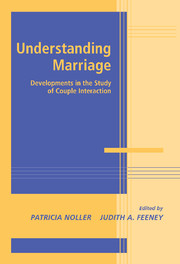Book contents
- Frontmatter
- Contents
- Contribitors
- Introduction
- SECTION ONE THE EFFECT OF COGNITION ON INTERACTION PATTERNS
- SECTION TWO UNDERSTANDING THE IMPORTANCE OF POSITIVE INTERACTION
- Introduction to Section Two
- 5 Observational “Windows” to Intimacy Processes in Marriage
- 6 Bases for Giving Benefits in Marriage: What Is Ideal? What Is Realistic? What Really Happens?
- 7 Shared Participation in Self-Expanding Activities: Positive Effects on Experienced Marital Quality
- SECTION THREE COPING WITH DISAPPOINTMENT, CRITICISM, AND BETRAYAL
- SECTION FOUR POWER, CONFLICT, AND VIOLENCE IN MARITAL INTERACTION
- Marital interaction at important transition periods
- SECTION SIX Interventions for strengthening relationships
- Conclusions
- Index
- References
7 - Shared Participation in Self-Expanding Activities: Positive Effects on Experienced Marital Quality
Published online by Cambridge University Press: 25 July 2009
- Frontmatter
- Contents
- Contribitors
- Introduction
- SECTION ONE THE EFFECT OF COGNITION ON INTERACTION PATTERNS
- SECTION TWO UNDERSTANDING THE IMPORTANCE OF POSITIVE INTERACTION
- Introduction to Section Two
- 5 Observational “Windows” to Intimacy Processes in Marriage
- 6 Bases for Giving Benefits in Marriage: What Is Ideal? What Is Realistic? What Really Happens?
- 7 Shared Participation in Self-Expanding Activities: Positive Effects on Experienced Marital Quality
- SECTION THREE COPING WITH DISAPPOINTMENT, CRITICISM, AND BETRAYAL
- SECTION FOUR POWER, CONFLICT, AND VIOLENCE IN MARITAL INTERACTION
- Marital interaction at important transition periods
- SECTION SIX Interventions for strengthening relationships
- Conclusions
- Index
- References
Summary
Uncertainty and mystery are energies of life. Don't let them scare you unduly, for they keep boredom at bay and spark creativity.
—R. I. FitzhenryThe period when two people first fall in love often seems to be characterized by energized and intense emotions, preoccupation with each other and the relationship, and great optimism. Yet over time, as the partners get to know each other, there is a typical decline in this exhilaration, often even a sense of apathy and boredom, a reduced interest in each other and the relationship, and a less idealized vision of the future. Indeed, a typical decline in love and satisfaction after the initial relationship period is one of the most well-documented findings in the study of marriage in Western cultures (for example, Blood & Wolfe, 1960; Glenn, 1990; Locke & Wallace, 1959; Rollins & Feldman, 1970; Tucker & Aron, 1993).
However, there is considerable variation in the rate of this decline (Tucker & Aron, 1993). One longitudinal study that followed newlyweds for four years found that as many as 10% showed an increase in marital quality over this period (Karney & Bradbury, 1997). In addition, studies of individuals who have been married 30 years or longer have found small but significant numbers who report high levels of passionate love (Traupmann & Hatfield, 1981; Tucker & Aron, 1993), including high scores on Hatfield and Sprecher's (1986) Passionate Love Scale with items such as “I would rather be with ___ than anyone else.”
- Type
- Chapter
- Information
- Understanding MarriageDevelopments in the Study of Couple Interaction, pp. 177 - 194Publisher: Cambridge University PressPrint publication year: 2002
References
- 35
- Cited by

